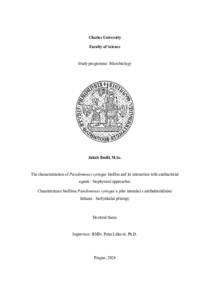The characterization of Pseudomonas syringae biofilm and its interaction with antibacterial agents - biophysical approaches
Charakterizace biofilmu Pseudomonas syringae a jeho interakcí s antibakteriálními látkami - biofyzikální přístupy
dissertation thesis (DEFENDED)

Item with restricted access
Whole item or its parts have restricted access until 21. 06. 2027
Reason for restricted acccess:
Protection of information protected by a special law
View/
Permanent link
http://hdl.handle.net/20.500.11956/191628Identifiers
Study Information System: 207234
Collections
- Kvalifikační práce [20326]
Author
Advisor
Consultant
Kromka, Alexander
Referee
Mackuľak, Tomáš
Viktorová, Jitka
Faculty / Institute
Faculty of Science
Discipline
Microbiology
Department
Department of Genetics and Microbiology
Date of defense
20. 6. 2024
Publisher
Univerzita Karlova, Přírodovědecká fakultaLanguage
English
Grade
Pass
Keywords (Czech)
Biofilm, Pseudomonas syringae, FT-IR spektroskopie, antibakteriální látkyKeywords (English)
Biofilm, Pseudomonas syringae, FT-IR spectroscopy, antibacterial agents3 Abstrakt Cílem této práce je využití techniky zeslabeného úplného odrazu (Attenuated Total Reflectance, ATR) u infračervené spektroskopie s Fourierovou transformací (FT-IR) k analýze tvorby in vitro biofilmu Pseudomonas syringae v průtokové komoře a jeho následné interakce s antibakteriálními látkami. Na základě naměřených ATR spekter v kombinaci s analýzou struktury biofilmu prostřednictvím světelné a fluorescenční mikroskopie jsem navrhl model vývoje biofilmu Pseudomonas syringae patovar morsprunorum CCM 2534 v průtokové komoře s 2% Luria-Bertani (LB) komplexním médiem. V tomto modelu je rozlišena počáteční kolonizace ZnSe hranolu (adheze) a následný oplach volně uchycených bakterií v důsledku výměny inokulační suspenze za čerstvé 2% LB médium, na který navazuje krátká perioda znovuosídlení uvolněného prostoru na substrátu. Následuje restrukturace biofilmu, kdy pohyblivá část populace Pseudomonas syringae migruje na vršek raných mikrokolonií, kde je vyšší dostupnost živin včetně kyslíku. Poslední fází je maturace biofilmu Pseudomonas syringae, která již probíhá převážně mimo dosah ATR FT-IR techniky a vede ke tvorbě mohutných mikrokolonií ve tvaru houbiček. V této práci jsem také zkoumal změny ve vývoji biofilmu Pseudomonas syringae za modelových podmínek (inokulace usmrcenými bakteriemi, inokulace...
4 Abstract The objectives of this thesis are the application of Attenuated Total Reflectance Fourier Transform Infrared (ATR FT-IR) spectroscopy for the analysis of Pseudomonas syringae biofilms grown in a flow cell and its subsequent interaction with antibacterial agents. Based on the combination of the recorded ATR spectra with the biofilm morphology analysis via light and fluorescent microscopy, I suggested a model for the development of Pseudomonas syringae pathovar morsprunorum CCM 2534 biofilm in a flow cell with 2% Luria-Bertani (LB) complex medium. This model consists of the initial colonization of the ZnSe prism (adhesion), subsequent washing of weakly attached cells due to the replacement of the inoculation suspension with the fresh 2% LB medium, which is followed by a brief substrate recolonization phase. Subsequently, the biofilm undergoes a restructuration with a motile subpopulation of Pseudomonas syringae migrating on top of already existing early microcolonies, where the availability of nutrients including oxygen is higher. The last developmental stage, a maturation of Pseudomonas syringae biofilms, is occurring predominantly outside the ATR FT-IR detection range and leads to a formation of large mushroom-shaped microcolonies. I also investigated the changes to the development of Pseudomonas...
